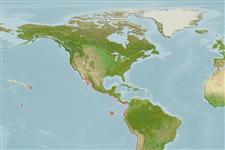Teleostei (teleosts) >
Holocentriformes (Squirrelfishes, soldierfishes) >
Holocentridae (Squirrelfishes, soldierfishes) > Holocentrinae
Etymology: Sargocentron: Greek, sargos = sargus + Greek, kentron = sting (Ref. 45335).
More on author: Gill.
Environment: milieu / climate zone / depth range / distribution range
Ecology
Marine; demersal. Tropical; 28°N - 2°S
Eastern Pacific: Gulf of California to Ecuador, including the Galapagos Islands.
Size / Weight / Age
Maturity: Lm ? range ? - ? cm
Max length : 25.4 cm TL male/unsexed; (Ref. 9307); common length : 15.0 cm TL male/unsexed; (Ref. 55763)
Dorsal spines (total): 11; Dorsal soft rays (total): 13 - 14; Anal spines: 4; Anal soft rays: 8 - 9; Vertebrae: 27. Body deep and somewhat compressed; caudal peduncle narrow; eyes large; pelvic fins with 1 spine and 7 soft rays (I, 7); preopercle with small serrations and a large, pointed spine at the angle; body violet pink; back bronze (Ref. 55763). Branchiostegal rays: 8-8 (Ref. 36626).
Adults hide in small caves or in crevices and cracks of rocks during the day. At night, they feed on small crustaceans in the intertidal zone, less than 3 m in depth. Oviparous, with planktonic larvae (Ref. 36626). Appear only occasionally in markets where it is sold fresh.
Life cycle and mating behavior
Maturity | Reproduction | Spawning | Eggs | Fecundity | Larvae
Oviparous (Ref. 36626). Also Ref. 240.
Schneider, W. and F. Krupp, 1995. Holocentridae. Candiles. p. 1182-1185. In W. Fischer, F. Krupp, W. Schneider, C. Sommer, K.E. Carpenter and V. Niem (eds.) Guia FAO para Identification de Especies para lo Fines de la Pesca. Pacifico Centro-Oriental. 3 Vols. FAO, Rome. (Ref. 9307)
IUCN Red List Status (Ref. 130435: Version 2024-2)
Threat to humans
Harmless
Human uses
Fisheries: bycatch
Tools
Special reports
Download XML
Internet sources
Estimates based on models
Preferred temperature (Ref.
123201): 23.2 - 29.1, mean 27.3 °C (based on 214 cells).
Phylogenetic diversity index (Ref.
82804): PD
50 = 0.5000 [Uniqueness, from 0.5 = low to 2.0 = high].
Bayesian length-weight: a=0.01660 (0.00788 - 0.03495), b=2.97 (2.80 - 3.14), in cm total length, based on LWR estimates for this Genus-body shape (Ref.
93245).
Trophic level (Ref.
69278): 3.5 ±0.48 se; based on food items.
Resilience (Ref.
120179): High, minimum population doubling time less than 15 months (Preliminary K or Fecundity.).
Fishing Vulnerability (Ref.
59153): Low vulnerability (15 of 100).
Nutrients (Ref.
124155): Calcium = 149 [50, 804] mg/100g; Iron = 0.959 [0.375, 2.974] mg/100g; Protein = 17.8 [16.8, 18.8] %; Omega3 = 0.251 [0.102, 0.617] g/100g; Selenium = 60.1 [31.2, 111.9] μg/100g; VitaminA = 19.3 [7.6, 47.8] μg/100g; Zinc = 1.79 [0.79, 3.50] mg/100g (wet weight);
